ISSN ONLINE(2319-8753)PRINT(2347-6710)
ISSN ONLINE(2319-8753)PRINT(2347-6710)
J. Sethy1*, D. Samal1, S. Sethi1, B. Baral1, S. Jena1, A. Payra2, G.N. Das2, B. Boruah2, H.K. Sahu3
|
| Related article at Pubmed, Scholar Google |
Visit for more related articles at International Journal of Innovative Research in Science, Engineering and Technology
Ecological investigation of species diversity and abundance of birds was conducted from May 2014 to February 2015 in and around North Orissa University Campus. Transect count and point count methods were used to investigate the abundance of birds. Observation was conducted by periodically walking along the study area early in the morning and late in the afternoon. Different diversity indices and statistical methods were used to analyze data collected during the field survey. A total of 130 bird species grouped under 94 genera and 50 families were recorded. Terrestrial habitat contributed much in terms of species composition (74.09%) than aquatic habitat (25.91%). We observed that terrestrial habitat had higher number of birds (589 individuals, 79.23%) than water birds (206 individuals, 20.77%). Shannon's diversity index indicate that terrestrial habitat had higher species diversity (H’ = 3.421) than aquatic habitat (H’ = 2.222). The overall birds’ diversity for both terrestrial and aquatic was (H’=3.707). Appropriate management of bird attractant sites is very important to discourage birds from the university campus
Keywords |
| species, diversity, abundance, birds, north orissa university |
INTRODUCTION |
| Bird community evaluation has become an important tool in biodiversity conservation and for identifying conservation actions in areas of high human pressure. Indian subcontinent is known for diverse and rich bird species whose taxonomy, distribution and their general habitat characteristics are well documented in India. Bird communities have been studied fairly well both in temperate and tropical forests. However, only a very little information is known about bird community structure and their dynamics in India. Understanding the diversity and structure of bird communities is essential to delineate the importance of regional or local landscapes for avian conservation. Determinations of bird population in different habitats are central to understanding the community structure and niche relationships, as well as for intelligent management of populations. Moreover seasonal monitoring is equally important to trace the dynamic movement of birds in such habitats. |
| Birds are among the most easily defined and readily recognized categories of animals, due to the presence of feather, which is unique to them. In addition to feathers, the development of forelimbs as wings, mostly for flight; feathered tail that serves for balancing, steering and lifting; toothless horny beak and skeleton exhibiting unique adaptations, mainly for flight and bipedal locomotion are characteristics of birds [1-2]. |
| Birds are both visually and acoustically conspicuous organisms of most ecosystems. Because they are comparatively easy to identify, birds have received considerable attention of humans [3-4]. Although they occupy most of the earth’s surface, most species are found only in particular regions and habitats, whereas others are cosmopolitan [5]. Patterns of abundance and distribution of birds are strongly related to environmental factors, which determine their presence and activity. The power of flight allows them to move easily through the air and yet they are perfectly adapted to every environment that fit their requirements for successful reproduction and survival [6-7]. |
| Birds of all types are drawn to open water for drinking, bathing, roosting and protection. Rainy periods provide temporary water pools at many airports. Many airports have permanent bodies of water near or between runways for landscaping, flood control, or waste water disposal purposes. These permanent sources of water provide foraging ground for a variety of bird species, with small fish, tadpoles, frogs, insect larvae, other invertebrates and edible aquatic plants. Temporary and permanent waters, including ponds, burrowed pits, swamps, and lakes attract groups of birds [8- 9]. |
| India harbours 1200 species of birds among 13% of the 9600 bird’s species of the world [10]. However, with the new classification coming in to force, the number of species may well be 1300 [11]. Urban biodiversity has received very little attention from conservation biologist as compared to natural and protected ecosystem [12-13]. [14] Have identified educational and defense premises that occupy less than 5% of the total urban area and are the hotspot for the urban biodiversity. Study of the avifauna in the educational premises of the country [15-19] has been completed. The main aim of this paper is to make comprehensive based line information of the bird species for the future as well as to create awareness for their conservation. |
STUDY AREA |
| State Orissa the Indian subcontinent extends from 17° 49’ N to 22° 34’ N Lat. and 81°27’E to 87° 29’ Longitude the eastern cost of India. Mayurbhanj lies between 21°16’ N and 22°34’ N Lat. and 85°E and 87° 11’ E Longitude and is the northern district of Orissa. |
| North Orissa University 21055’ 56.5” N and 86044’47.3” E) is located 5 Km. from south of the District Headquarters, Baripada in Mayurbhanj District at the foothill of the Similipal Tiger Reserve, Orissa. It is the representative ecosystem under Mahanadian Biogeographic Region. Remarkably its flora and fauna composition have some similarities with elements from the Western Ghat and Northeatern India. The University campus encompasses an area of 110 acre land with varied habitat. The area under study is referred as to North Orissa University, which encompasses the main University campus. |
| The vegetation is dominated by large trees like Mangifera indica, Shorea robusta, Azadiracta indica, Ficus benghalensis, F. religiosa, the flowering plants including Radhachura, Krishanachura, Albizzia spp., Caesalpinia spp., etc. However, the campus is mainly dominated by the mango plants. |
METERIALS AND METHODS |
| Data were collected using three methods: transect walk, point transects and direct observations during May 2014 to February 2015. Line Transect method was used for the bird survey. This method proved most efficient in terms of data collection per unit effort [20]. This census involves an observers moving slowly along the routes and recording all birds detected on either side of the route. The length of transects depend on the type of survey but is usually constrained by accessibility and thus may not be fixed. Line transects are often used to collect data in large, open areas and is more efficient than point count as one tends to record more birds per unit time. |
| The most of surveys on the wetland’s avifauna were conducted between November 2014 and February 2015 using a transect line approach [21] to extensively survey throughout the wetland area so as to assess the avifauna species and abundance. Line Transect method proved most efficient in terms of data collection per unit effort [20]. A total of three transects were established along the various flat terrains available within the field areas. Each transect had a total length of 500 m, with 100 m of sub-transects. For each transect, an observer recorded any bird species and numbers in the area with the aid of binoculars. Sampling sites followed the established transect on the terrestrial area and with an interval of 100 m apart. A total of ten observation sites were established with an interval of 200 m apart. For water birds, observation sites were established at the edge of the Dam at an interval of 100 meter from one site to another, whereby two sites were established. In each site, birds’ observations were carried out twice daily; morning between 0630 to 1000 h and evening, between 1600 and 1800 h by walking slowly along transects. Birds were counted as bird seen and heard and birds in flight were also recorded. The birds were identified using Nikon binoculars (10x50) and field guides of [22] and [23]. |
Data analysis |
Bird species diversity and evenness |
| The relative abundance of a species was obtained by dividing the abundance of a species by the total abundance of all species combined based on the assumption that the frequently seen the species the more abundant it is [21]. Birds’ diversity was calculated using both Shannon-Weiner and Simpson’s diversity indices. Shannon-Weiner diversity Index ‘H’ was calculated using the formula: |
 |
| Where, Pi = Proportion of individual species and R = total number of species of the community (number seen and heard). Simpson’s diversity Index ‘D’ was calculated using the formula: |
 |
| Where, ni = the total number of birds of each individual species and N = the total number of birds of all species. The value of D ranges between 0 and 1. With this index, 1 represents infinite diversity and 0, no diversity. |
RESULTS AND DISCUSSION |
| A total of 795 individual birds representing 130 species, 50 families and 94 genera were observed in and around North Orissa University campus (Tables 1). The maximum (7.69%) of species were recorded Muscicapidae family, followed by Ardeidae (6.15%), Sturnidae (4.62%), Columbidae Cuculidae, Sylviidae and Motacillidae with (3.85%) species each. The Estrildidae family represented by (3.08%) of species, Accipitridae, Rallidae, Psittacidae, Alcedinidae, Ramphastidae, Picidae, Campephagidae, Laniidae, Oriolidae, Dicruridae, Corvidae, Hirundinidae, Pycnonotidae, Cisticolidae with (2.31%), species in each, Threskiornithidae, Phalacrocoracidae, Charadriidae, Jacanidae, Scolopacidae, Strigidae, Apodidae, Monarchidae, Alaudidae, Turdidae, Dicaeidae and Nectariniidae with (1.54%) sixteen families were represented by single species each were recorded during the study periods (Figure 1). |
| Terrestrial habitat contributed much in terms of species composition (74.09%) than aquatic habitat (25.91%). We observed that terrestrial habitat had higher number of birds (589 individuals, 79.23%) than water birds (206 individuals, 20.77%) (Figure 2). However, in overall abundance, Red-vented bulbul (Pycnonotus goiavier) had the highest relative frequency followed by Common mayna, Rufus tree-pie cattel egret and little bee-eater. Higher relative frequency of birds could be contributed by high frequency of occurrences to some of the birds in different sites. |
| Most of the birds observed and recorded higher in winter followed by summer and fall seasons (Figure 3). During the winter seasons, the maximum no of species in Mango Orchard followed by Biotech department, University Gate, Ranibandh, Plantation and Old Canteen were recorded during the study periods. In summer, the maximum number of species in Mango Orchard, followed by Plantation and University Gate were recorded. Same as in Fall, Mango Orchard, Plantation. [24] Reported the diversity and species richness of birds are expected to be highest during winter when migratory population arrive and minimum during monsoon when the migratory populations leave the area and the resident species are engaged in the nesting activities. The most of birds observed during this study were resident and migratory species. [25] reported that the species that are winter migrants use wetlands for rest and other activities while waiting for the favourable condition of their home range. They involved in activities that afford them opportunity to store enough fats for the journey back to Europe [25]. |
| Also, higher number of birds in terrestrial habitat may be attributed to the terrestrial habitat having greater resources such as food and nesting sites and a resulting ability to support more birds [26-27]. |
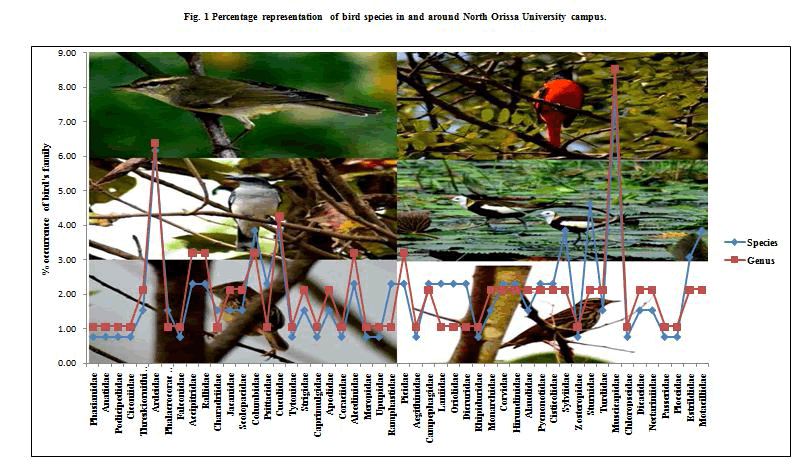 |
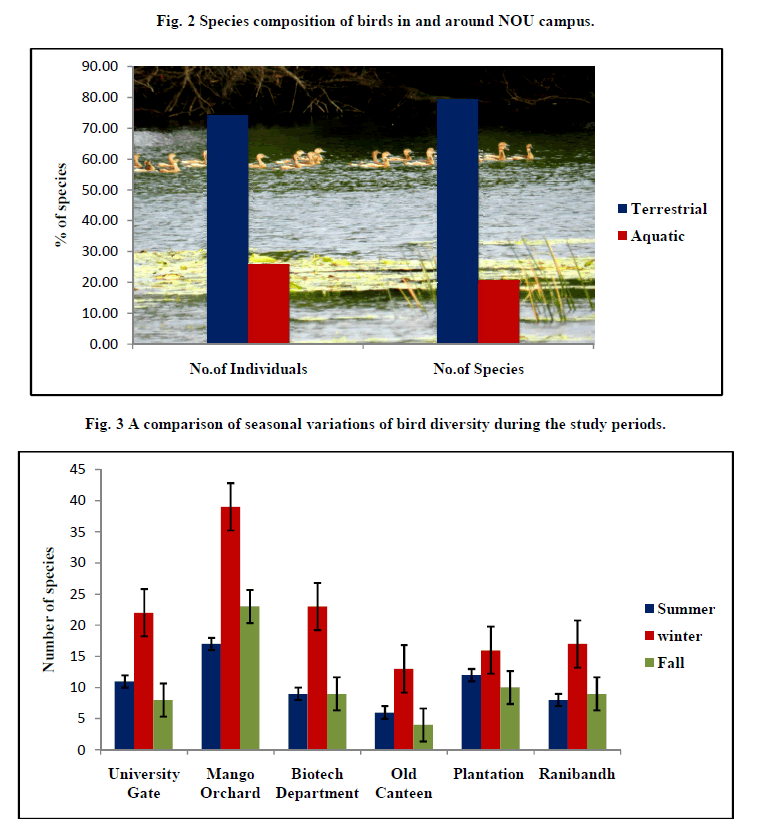 |
| It was observed that certain grass species produced seeds which attracted grain-eating birds for example Ploceus philippinus to inhabiting the area. Trees such as Ficus spp., Azadrachita indica and Syzigium spp, produced fruits, which were preferred food for some birds such as P. goiavier, Paradise flycatcher (Terpsiphone paradisi) and Goldenfronted Leafbird (Chloropsis aurifrons). [28] Reported that bird species richness and diversity within wetlands were positively correlated with percent cover of trees. [29] Pointed out that bird abundance and varieties rise with increase in food availability. The higher abundance of birds in terrestrial habitat could also be due to the composition of the vegetation that forms the main element of their habitat [30-32]. The lower number of water birds could be attributed to the destruction of the wetland habitats, due to overgrazing, and cultivation. The riverine vegetations near the dam were observed to be heavily overgrazed by cattle which use the areas around the dam as feeding areas and vegetation cleared due to cultivation thus interfering with the area which could be used for nesting, feeding, and breeding sites for wetland birds. A study conducted in Niger by [33] revealed that the most important threat for White storks (Ciconia ciconia) was the degradation of wetlands which were ideal habitats for roosting and thermoregulation. The reduction of bird population may have been contributed by degradation of wetlands and the loss of suitable upland habitats that surround wetlands making no value to wetland dependent birds [34]. |
Bird species diversity |
| The species diversity index fluctuated from 3.415 (site- Mango orchard) to 2.049 (site- Plantation) (Figure 4). The highest diversity was shown in Mango orchard, while Plantation had the lowest diversity. Apart from the diversity, species evenness has shown variation in the sites with values of 0.785 (site-Ranibandh), 0.845 (site-Mango orchard), 0.847 (site-Old canteen), 0.862 (site-Plantation) 0.876 (site-Biotech department) and 0.880 (University gate). The variation in species diversity and species evenness at various sites may be due to the influx of visitors, vehicles and local people in and near the campus and the availability of food to the birds. |
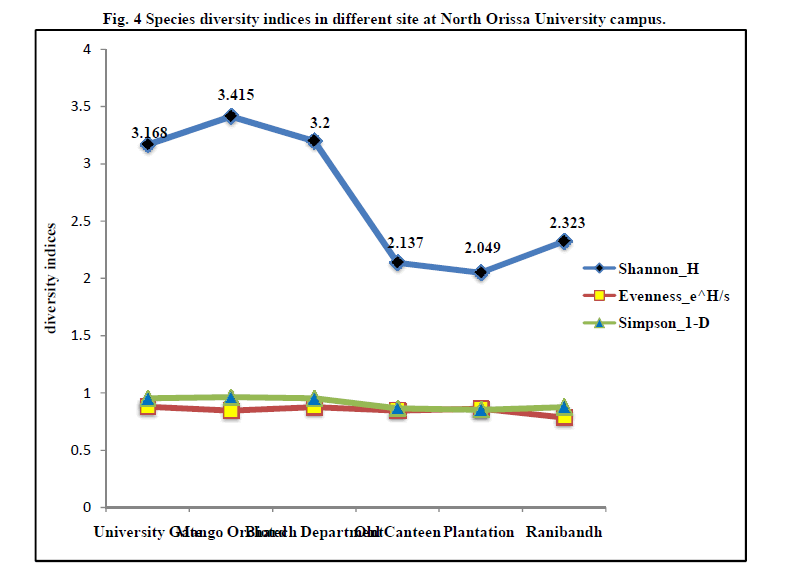 |
| Shannon's diversity index indicate that terrestrial habitat had higher species diversity (H’ = 3.421) than aquatic habitat (H’ = 2.222) (Figure 5). The overall birds’ diversity for both terrestrial and aquatic was (H’=3.707). On the other hand, the Simpson’s diversity index for terrestrial birds and water birds were 0.962 and 0.868 respectively. However, the overall Simpson’s diversity index for the two habitats was 0.970. This indicates greater variation in species diversity between the results obtained by using Shannon's and Simpson’s diversity indices. This is because Simpson’s diversity index takes into consideration relative abundance which is not the case for Shannon's diversity index. The higher diversity in terrestrial habitat may be due to high numbers of individuals in some of bird species (15 species had above 10 individuals) compared to water bird species (only 2 species which had individuals above 10 individuals) and diverse vegetation types as microhabitats which favoured varieties of bird species. The anthropogenic activities such as parking lots, housing developments and agricultural fields may have changed the diversity in the area which is well reflected by the species composition before human intervention [35] |
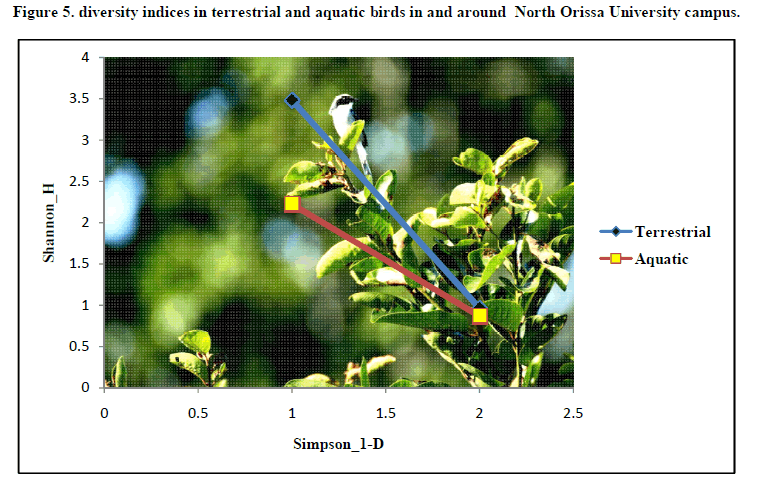 |
ACKNOWLEDGEMENTS |
| The author wishes to express deep sense of gratitude to Prof. P. Mishra, Vice Chancellor for encouragement and support and also thankful to the all the teaching staffs of P.G. Department of Zoology, North Orissa University. |
References |
|
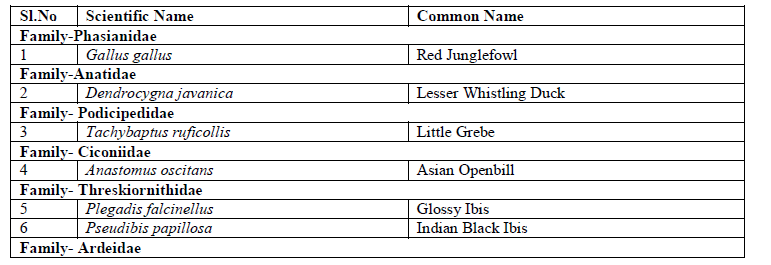 |
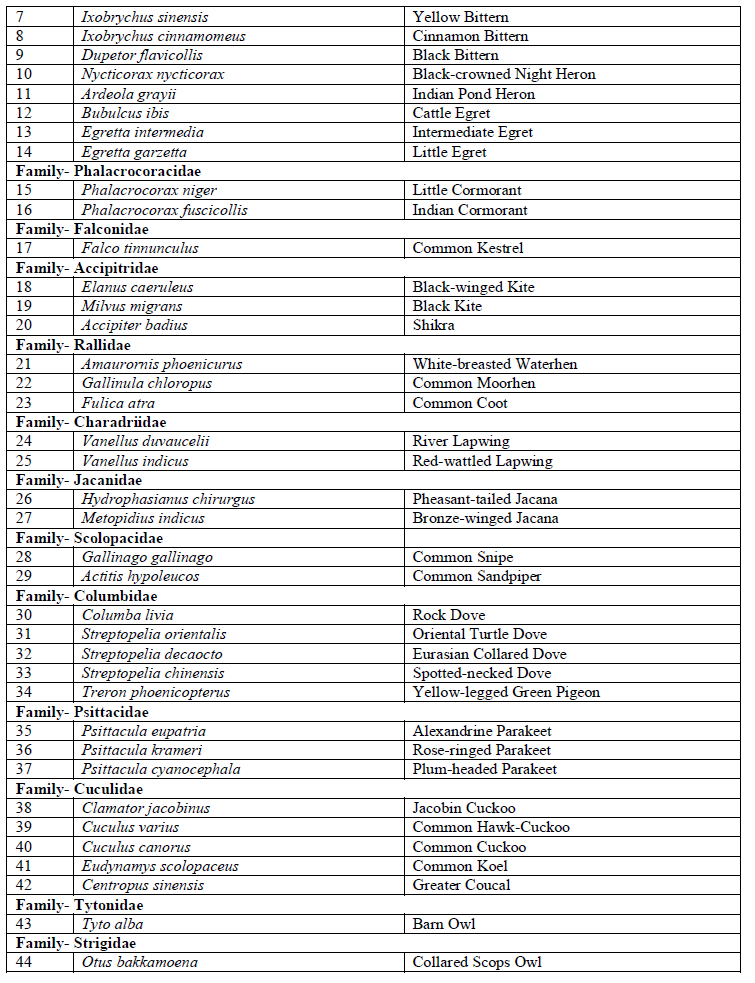 |
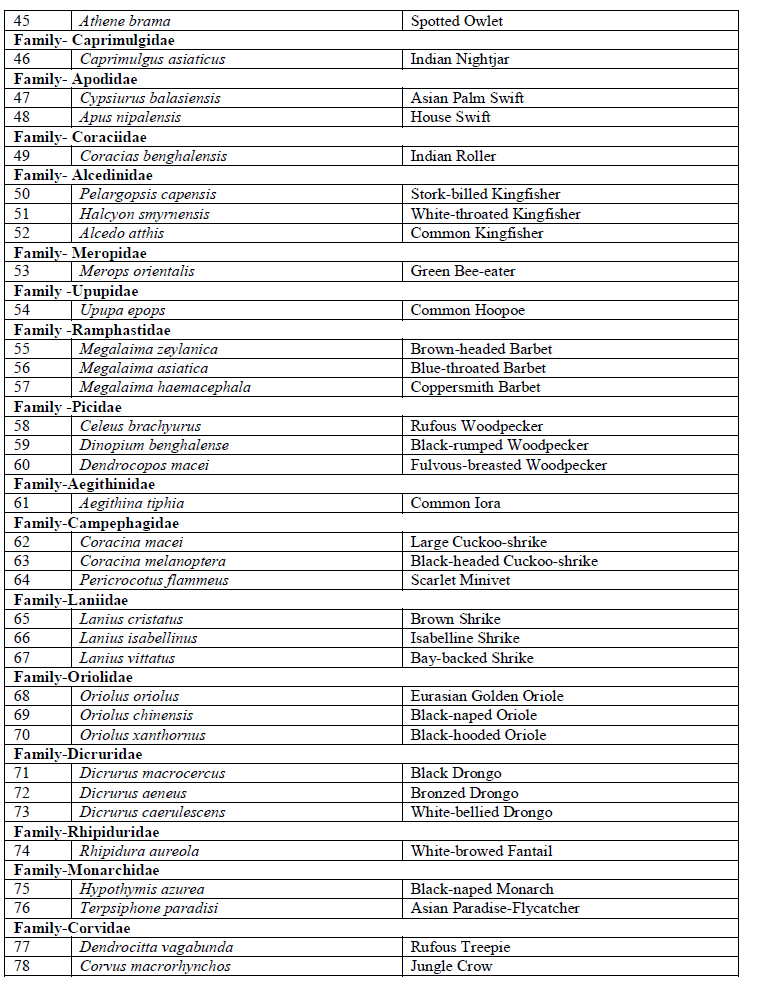 |
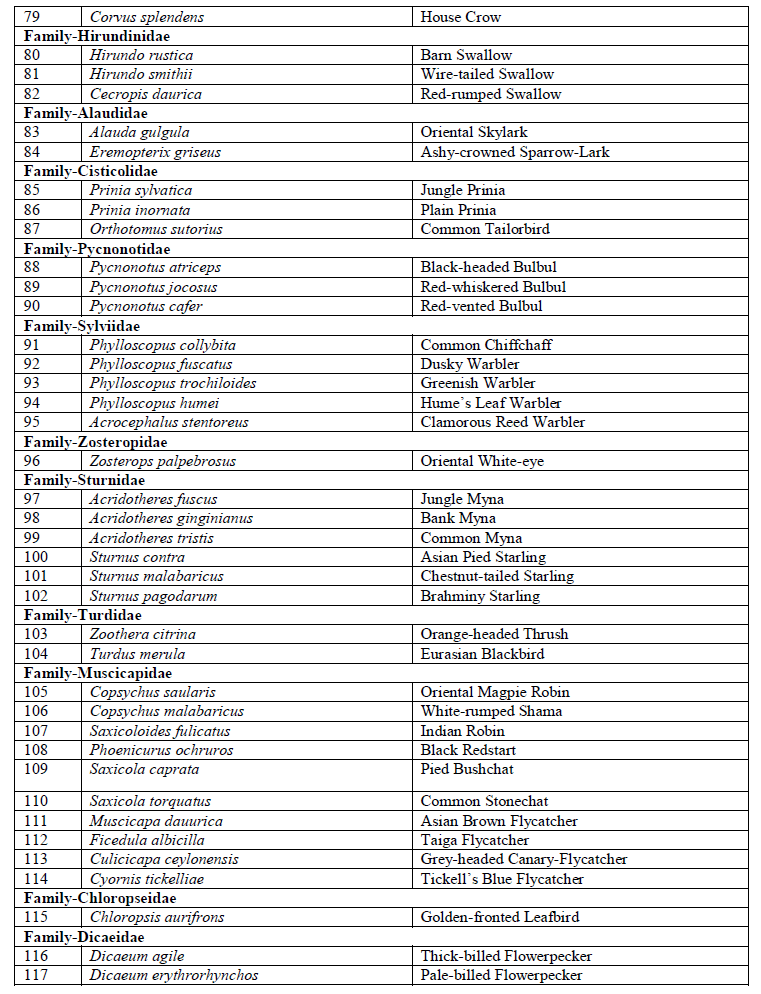 |
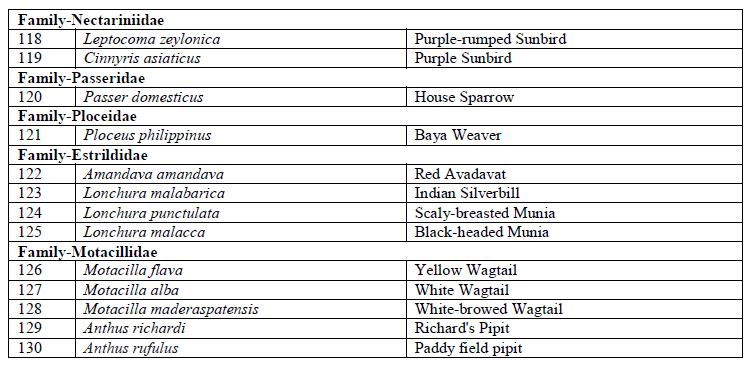 |